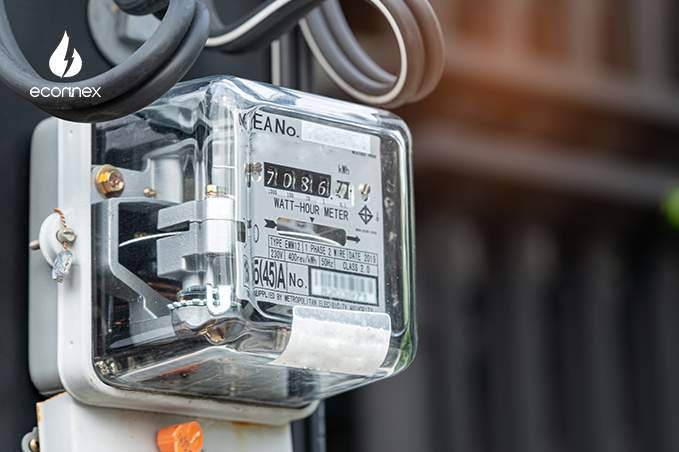Maximise savings by improving your understanding of peak and off-peak electricity times in Australia with the help of Econnex Comparison's insightful guide.

Published on 12/02/2024
By William Walton
Econnex Comparison
As the energy market in Australia continues to develop and shift, consumers need to understand and leverage the concepts of peak and off-peak electricity times. You could create actual household savings by taking the time to identify if these are a feature of your chosen energy plan and adjusting your appliance use accordingly. A few simple behavioural changes, such as ensuring that you wash clothes during a specific window during the day, might be all that is required.
In layperson’s terms, if you have a ‘time-of-use tariff’ for your energy plan, then your electricity cost will vary at different times of day. The price increases during times of peak grid loading and correspondingly drops during the quieter off-peak times. This pricing model is designed to incentivise Australian consumers to use their appliances when the grid is experiencing less overall demand, such as in the middle of the day.
Ideally, this should help distribute power to households more evenly across the day, leading to greater grid security and preserving our energy infrastructure.
Let’s explore further.
The demand for electricity within Australia is not consistent throughout the day. It waxes and wanes, depending on factors such as:
For example, during the early evening, when more household members are likely to be home and turning on appliances, the demand on the grid is higher than at other times of the day. Therefore, this rush hour period is a peak time for electricity use, which could strain our energy infrastructure with the increased load.
Conversely, off-peak electricity periods correspond to times of the day when the demand on the grid is low, such as during the middle of a weekday when many consumers are out of the house. From the perspective of grid stability, it’s desirable to try and ensure that the gap in demand between peak and off-peak times is as minimal as possible. Otherwise, the grid will need to cope with large surges in loading as the day progresses, which may cause problems for retailers and consumers.
Another term that might confuse you on your energy bill is a ‘shoulder rate’. Generally speaking, this is a halfway rate between peak and off-peak rates that occurs as one transitions across to the other. For example, a retailer may offer a plan with off-peak hours from 10 p.m. to 7 a.m., a shoulder rate from 7 a.m. to 2 p.m., and a peak rate from 2 p.m. to 8 p.m.
Remember to clarify each of the rates applicable to your plan and when they apply to optimise your energy spending.
It's important to note that peak and off-peak electricity periods can vary between different retailers and states. For instance, in New South Wales, off-peak times might be designated from 10 p.m. to 7 a.m.; in other states, these times may differ, even from the same retailer, to reflect residents' different energy consumption habits. Consumers need to clarify which times are relevant to them before adjusting any behaviour or appliance usage to create energy savings.
Let’s explore some of these differences in more detail, using Energy Australia as an example (data accurate as of 9/11/23).
For Energy Australia FlexiPower - 5 Day Time-of-Use customers in Sydney (2000), different times apply between different seasons. In the Summer months, the times are as follows (all pricing is sourced using Energy Made Easy from the Australian Energy Regulator):
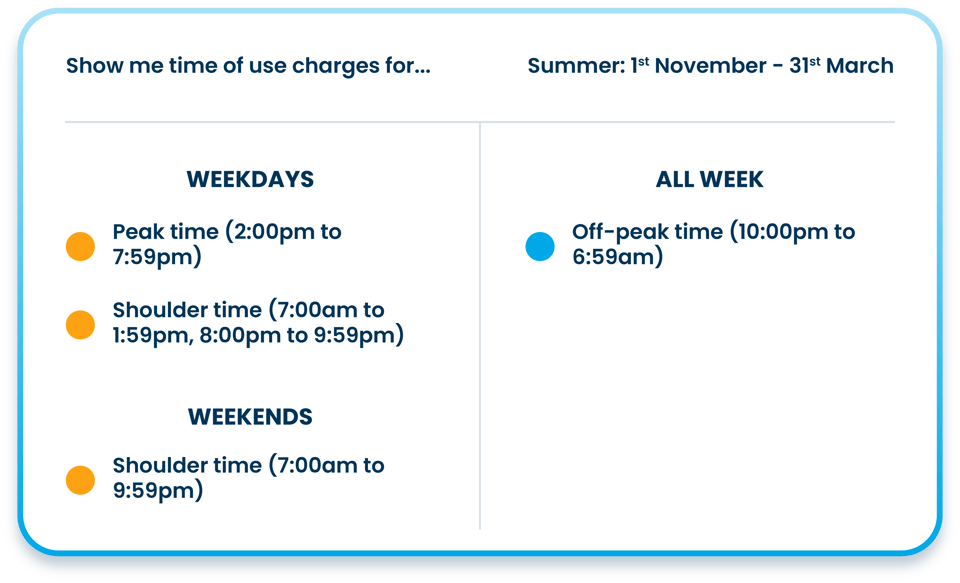
In Winter for the same plan, however, these times change to reflect the shorter days and adjusted behaviours households make to deal with the cold:
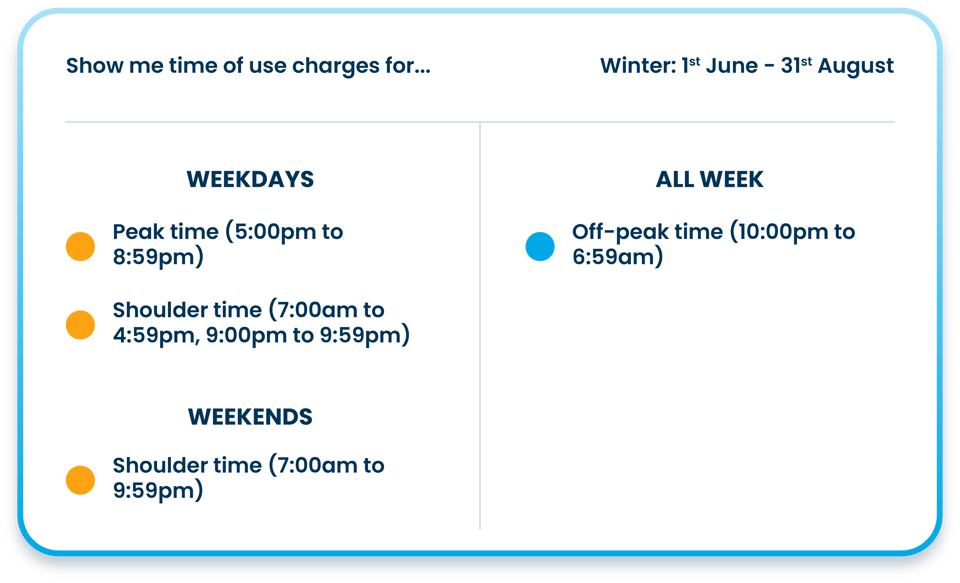
So, let’s search across broader NSW to see how those times compare. Using the regional centre of Tamworth (2340) as an example, for the same plan, we can see that the peak and off-peak times are consistent throughout the year, in contrast to Sydney.
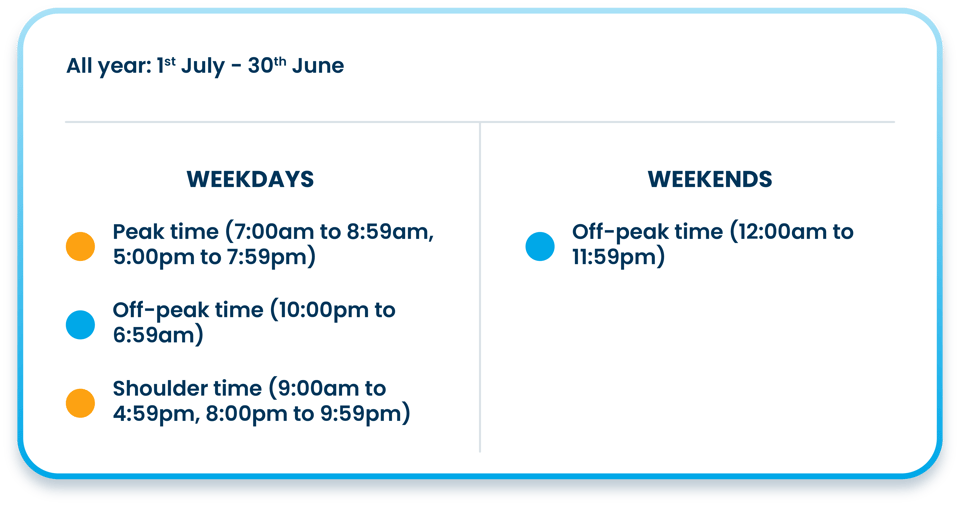
Widening our gaze to Victoria, if we explore peak and off-peak times for the comparable Energy Australia FlexiPower – Residential Time of Use plan for Melbourne (3000), we can see that they are different again.
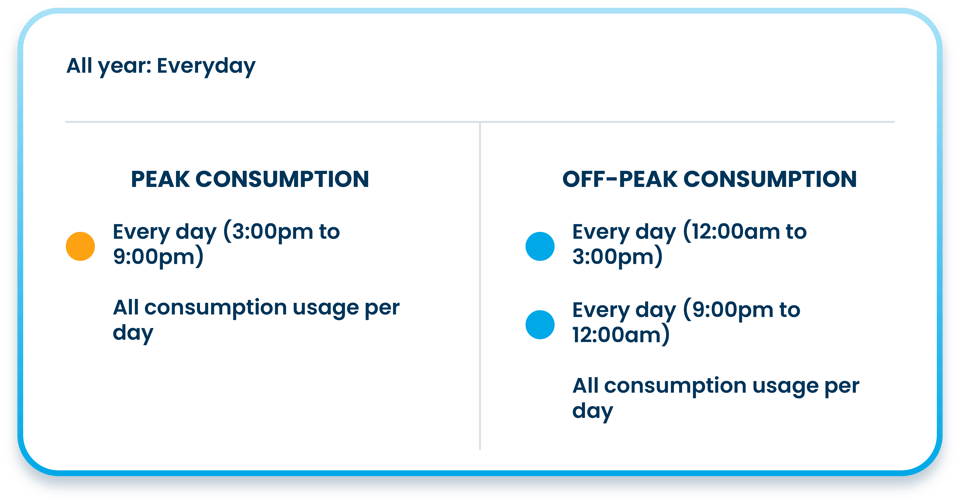
Queensland is different again. If you currently (as of 9/11/23) search for Energy Australia plans in Brisbane (4000), you’ll find that there are none with a time-of-use tariff applied. Instead, the options are single-rate plans, some with what’s known as a ‘demand charge’ or ‘capacity charge’, as described below:
Residential Demand Charge (per Energy Australia): A charge per day for the maximum half hourly demand (maximum quarter hourly for 15 minute interval meters) between 4pm to 9pm in a calendar month. Demand reading only provided if your network tariff supports it, otherwise it will appear as 0.
Essentially, this plan feature means that it may be worthwhile for applicable QLD residents to spread the use of high-capacity appliances over peak periods instead of turning them all on at once. The higher a resident’s maximum energy usage over a half-hour interval during peak times, the higher the demand charge will be.
To understand the impact of peak and off-peak electricity times on your bill, it's helpful to start with the basics. In Australia, electricity bills are typically split into two main charges: a fixed daily supply charge and variable usage charges. The variable component is where peak and off-peak considerations come into play. However, it's important to note that not all consumers have plans with a ‘time-of-use tariff’ that accounts for peak or off-peak, with some opting for a single-rate tariff on variable usage.
For those on this single-rate tariff, the cost per kilowatt-hour (kWh) remains the same, no matter what time of day electricity is used. This straightforward pricing structure can suit households with consistent energy consumption patterns, offering predictability and ease of understanding regarding their bills. That said, it doesn't provide the opportunity to save money by shifting usage to cheaper, off-peak periods.
However, if you do have an energy plan with a time-of-use tariff applied to variable usage, you should take advantage of any off-peak periods to create household savings. There may be an approximate difference of 40c/KWh or more between peak and off-peak rates from your retailer, constituting an increase during peak demand of more than 200% (based on prices effective in August 2023)!
That’s highly significant and could make a real difference come billing time.
A solar system, especially one with a battery installed, may combine well with an energy plan featuring a time-of-use tariff. Such systems generate most of their energy during daylight hours, which may not align with your use of appliances. However, the battery storage component allows you to save that generated electricity for use during the more expensive peak hours of the day.
One of the innovations in energy technology that better allows consumers to manage their energy costs proactively is the introduction of smart meters into the market. These new digital meters communicate directly with the retailer to provide a detailed breakdown of energy use, eliminating the human error often involved with sending a technician to take a reading.
Previously, analogue meters offered residents very little ability to track their energy use at different times of day. No longer, as smart meters provide the critical ability to log in on your preferred digital device, usually via an app, and determine precisely how much energy you’re consuming at any given time.
This real-time data is essential to optimising the efficiency of your appliance use during off-peak times. In fact, you can only apply for a plan with time-of-use tariffs applied if a smart meter is installed on the property. Otherwise, with analogue meters, there’s no way of telling exactly when energy was used, only how much in total.
Not only do these new meters allow you to sign up for plans with variable pricing across the day, but they also allow you to make the most of them. Monitoring your real-time smart meter data may indicate important details that can change your behaviours, including which appliances use the most power when operating and which may be draining power during standby mode.
If you have a time-of-use tariff applied to your energy plan, you can implement several changes in your appliance use to optimise your energy spending. Some of our suggestions include:
Some retailers may even offer demand-response incentive programs encouraging consumers to reduce their energy consumption during peak hours to take some of the strain off the grid. For example, AGL offers a Peak Energy Reward program that provides bill credits to eligible consumers who reduce their consumption during ‘peak events’ when demand is exceptionally high. Similarly, Energy Australia has also introduced a program called Power Response along the same lines.
While there can be several benefits to leveraging plans with off-peak energy rates, it all depends on factors such as your schedule. If household members aren’t at home during off-peak hours (as is typical for many employees) and your appliances don’t have timer or delay-start features, you may be unable to take advantage of the lower prices. In such circumstances, a single-use tariff may be more convenient.
However, suppose you are at home during off-peak periods or have implemented a solar battery system for your house. In that case, you may be able to create significant savings on your energy expenditure. It all depends on your individual circumstances.
Whichever type of plan you decide to go with, you’ll likely find several options from our panel of retailers on Econnex Comparison. You can compare different providers available in your area, select the plan that best suits your needs, and apply online within minutes. It’s the intuitive comparison platform that puts the control in your hands: no ads, no sponsored products, and no fuss.
Let’s get started.
